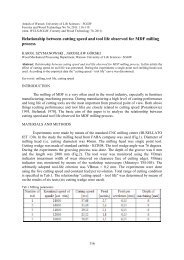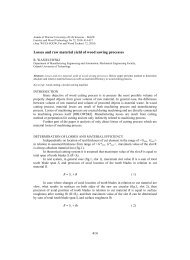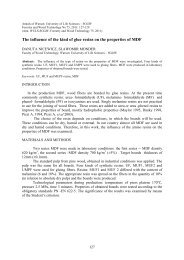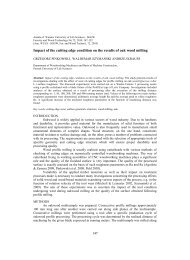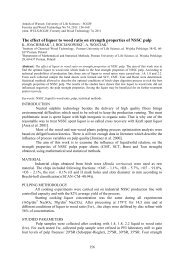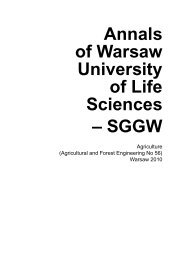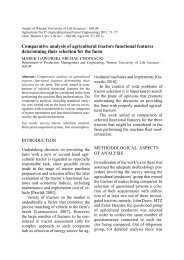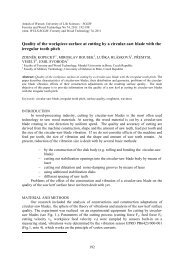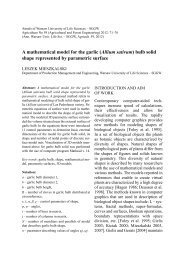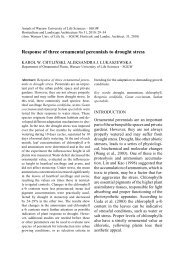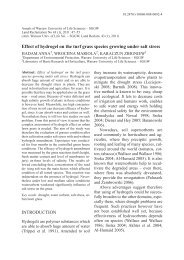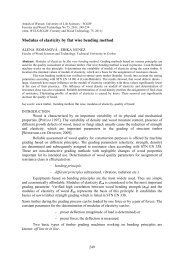Annals of Warsaw University of Life Sciences - SGGW
Annals of Warsaw University of Life Sciences - SGGW
Annals of Warsaw University of Life Sciences - SGGW
You also want an ePaper? Increase the reach of your titles
YUMPU automatically turns print PDFs into web optimized ePapers that Google loves.
The 18 th -century ro<strong>of</strong> frames are with no exception the queen-post structures. Rafters<br />
<strong>of</strong> their principals/trusses characterize with indicators <strong>of</strong> slenderness <strong>of</strong> free sections<br />
comprised within 13,5 – 21,6 limits. In ro<strong>of</strong>-frames <strong>of</strong> standing queen-posts that parameter<br />
oscillates within 13,5 – 17,0 limits, thus the average value is higher, then in 17 th -century ro<strong>of</strong>frames.<br />
In structures <strong>of</strong> reclining queen-posts the free section <strong>of</strong> rafters are still more slender,<br />
which is expressed by the indicator close to 21. Rafters <strong>of</strong> all ro<strong>of</strong>-frames <strong>of</strong> standing queenposts<br />
have rectangular cross-sections expressed by the h/b indicator comprised within the 1,25<br />
– 1,3 limits. Thus they are distinctively different from rafters <strong>of</strong> ro<strong>of</strong>-frames <strong>of</strong> reclining<br />
queen-posts, that have square cross-sections.<br />
Queen-post and purlin ro<strong>of</strong>-frames executed in 19 th century include rafters <strong>of</strong> diverse<br />
slenderness <strong>of</strong> free sections and diverse shape <strong>of</strong> cross-section. In two structures <strong>of</strong> standing<br />
queen-posts the first <strong>of</strong> those parameters assumes values 13,0 and 18,5, that is similar to<br />
rafters <strong>of</strong> the 18 th -century ro<strong>of</strong>-frames. In structures <strong>of</strong> reclining queen-posts the situation is<br />
opposite, the slenderness indicator is low, equaling 9,6, that is comparable with values<br />
common in Medieval structures.<br />
REFERENCES:<br />
1. MENZEL C.A, Die Hölzernen Dachverbindungen in ihrem ganzen Umfange. Halle,<br />
1842, p. 177 and further<br />
2. ZABIERZOWSKI A., Przewodnik praktyczny dla budujących. Warszawa, 1857, p.<br />
269 and further.<br />
3. GOGOLIN M. R.: Więźby dachowe kościołów pomorskich od XIII do połowy XIX<br />
wieku. Bydgoszcz, 2008<br />
Streszczenie: Smukłość swobodnych odcinków krokwi i kształt jej przekroju poprzecznego<br />
jako cechy charakteryzujące konstrukcje historycznych więźb dachowych. W artykule<br />
przedstawiono wyniki badań nad wybranymi parametrami, charakteryzującymi konstrukcje<br />
więźb dachowych powstałych w okresie XIII – XIX w. Wzięto pod uwagę takie wskaźniki,<br />
jak smukłość najdłuższych odcinków swobodnych krokwi oraz proporcje wymiarowe ich<br />
przekroju poprzecznego i skonfrontowano je z zaleceniami zamieszczanymi w dawnych<br />
podręcznikach budowlanych. Uznano, że analiza tych parametrów pozwoli na zdefiniowanie<br />
charakterystycznych cech warsztatu wykonawczego cieśli w rozpatrywanym okresie.<br />
Corresponding author:<br />
Uniwersytet Kazimierza Wielkiego w Bydgoszczy,<br />
Instytut Techniki, Katedra Konstrukcji Drewnianych;<br />
ul. Chodkiewicza 30, 85-064 Bydgoszcz<br />
e-mail: argus@ukw.edu.pl<br />
37



